DAMSL-272 Computer Vision
Type
Elective
Course Code
DAMSL-272
Teaching Semester
B semester
ECTS Credits
10
Syllabus
- Introduction to Computer Vision
- Overview of Image Acquisition and Processing Topics(Sampling, Quantization, Color Perception, Smoothing Filters, Derivatives)
- Overview of Image Analysis Topics(Edge Detection, Segmentation)
- Representation, Analysis, and Synthesis of Textures
- Interest Point Detection(Harris Corner Detector)
- Blob Detection
- Descriptors of Interest Points(SIFT)
- Hough Transform
- Methods for Estimating Parametric Models (Least Squares Method)
- Robust Parameter Estimation Methods (LMedS, RANSAC)
- Alignment of Model-Image Based on Features
- Camera and Lens Models, Projective Geometry
- Camera Calibration
- Epipolar Geometry
- Stereo Vision: The Correspondence Problem and 3D Reconstruction
- Volumetric 3D Reconstruction from Multiple Cameras
- Estimation of 2D Motion(Vertical Optical Flow, Optical Flow)
- Modeling 3D Motion(Motion Field, Eigenmotion)
- Tracking of Linear Dynamic Models
- Tracking with Particle Filters
- Object Detection(Human Body, Face)
- Object Detection
- Object classification
Learning Outcomes
- Having attended and succeeded in the course, the student is able to describe how specific, selected problems in computer vision are addressed in the relevant literature.
- Having attended and succeeded in the course, the student has achieved an in-depth understanding of the mechanisms for solving specific computer vision problems and can explain the reasons that make these mechanisms sufficient for solving other problems.
- Having attended and succeeded in the course, the student can reuse existing methodologies and tools to generate other solutions for solving specific instances of computer vision problems or developing applications.
- Having attended and succeeded in the course, the student can critically evaluate specific problems and perceive them as compositions of a series of individual sub-problems.
- Having attended and succeeded in the course, the student can combine individual tools and methodologies to achieve the solution of complex computer vision problems.
- Having attended and succeeded in the course, the student can measure/quantitatively assess the quality of solutions to computer vision problems and compare these solutions to other existing ones
Student Performance Evaluation
Homework and/or Lab Assignments, Final Exam and/or Project
Prerequisite Courses
Linear Algebra
